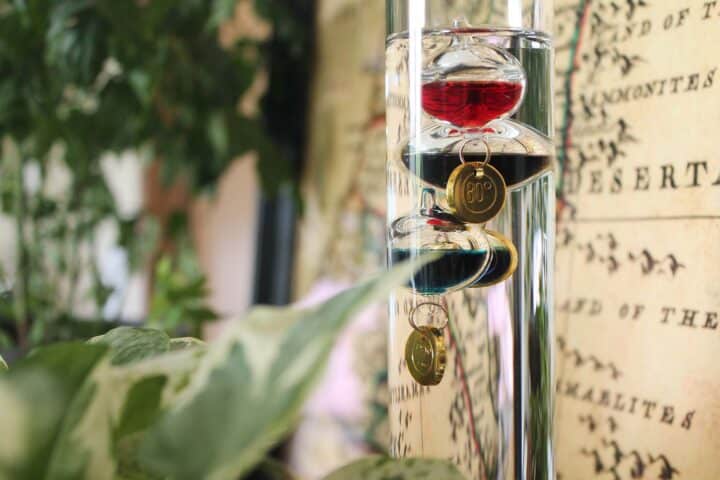A Galileo Thermometer is a sealed glass tube filled with liquid, typically ethanol, with glass spheres filled with colored liquids and weights attached. As the temperature changes, the liquid expands or contracts, which allows the glass bubbles to rise and fall. The number on the metal tag of the lowest sphere is the temperature.
While the instrument bears the name of the great Italian physicist Galileo Galilei, he did not invent the thermometer. However, the physical principles he discovered some four centuries ago make this glass thermometer a reasonably accurate ambient temperature measurement compared to modern digital thermometers.
Top Picks

This 20" tall Galileo thermometer is one of the larger models available and is perfect for an office or living room area.

The Storm Glass Weather Predictor may not really work, but it's a conversation piece at least.

Lily's offers both the Galileo thermometer and the Fitzroy Storm Glass in a really nice-looking piece.
Who invented the galileo thermometer?
Galileo thermometers are named after the Italian physicist Galileo Galilei. However, the instrument itself was created by researchers at the Accademia del Cimento of Florence sometime in the mid-1600s. One of the researchers on the team, Torricelli, worked with Galileo on research surrounding the concepts of the thermometer.
As the temperature of the liquid changes, the weighted spheres begin to move. While these thermometers are not particularly accurate, they are generally accurate enough to give an idea of your indoor temperature within a few degrees.
[embedyt] https://www.youtube.com/watch?v=W_xc-6662f8[/embedyt]How to read a Galileo thermometer
Galileo thermometers are unique devices that use the principles of both buoyancy and density to measure temperature. The thermometer consists of a glass container filled with a clear liquid and several spheres with weights of different densities. The weighted spheres are free to move up and down the glass container, each labeled with a different temperature.
As the temperature of the liquid changes, the metal balls either float or sink until they reach a position where the liquid has the same density as the metal ball. The temperature is read on the medallion of the lowest sphere.
Best Galileo Thermometers
Wind & Weather Galileo Glass Thermometer
This 20" tall Galileo thermometer is one of the larger models available and is perfect for an office or living room area.
Wind and Weather have become synonymous with quality traditional weather instruments, and its 20″ tall hand-blown Galileo Thermometer is no different. However, given its height, you’ll need an open spot to place this one. But you’ll be able to read this one from a distance.
Lily's Home Round Galileo Thermometer
Lily's globe-like design with this tabletop Galileo thermometer gives it a unique look.
We like Lily’s Round Galileo Thermometer just because it’s different. Most thermometers you’ll see are long cylindrical tubes. Here, Lily has placed the thermometer inside a globe-like stand, which takes up less room. Reviews are pretty solid too, and it doesn’t seem to operate any less accurately than a traditional-style cylindrical Galileo thermometer.
AcuRite Galileo Thermometer with Glass Globe Barometer
AcuRite's Galileo Thermometer also includes a glass globe barometer, also inspired by his original instruments.
In addition to the thermometer, Galileo also used a glass barometer to study differences in air pressure. AcuRite has combined both these instruments into a nice piece measuring eight inches long and eight inches high, which looks great on a desk.
The Storm Glass Weather Predictor may not really work, but it's a conversation piece at least.
The Fitzroy Storm Glass is a weather forecasting tool used by sailors in the 19th century. The glass is filled with a mixture of water and chemicals, and the crystals that form within the glass can predict the weather. According to legend, the weather will be fair if the crystals are clear. If they are cloudy, then it will be rainy. If they are clear, then the weather is fair. While the scientific evidence for this claim is scant, many people still believe in the power of the Fitzroy Storm Glass. As a result, it has become a popular decoration in homes and offices.
The Storm Glass Weather Predictor is an excellent gift for weather geeks. With a simple yet elegant design, the Storm Glass Weather Predictor is a great decorative piece for the home that you can place anywhere.
More than a piece of home decor, the Storm Glass Weather Predictor is a “weather instrument” that predicts weather changes. The chemical mixture inside the glass experiences changes in crystallization based on weather conditions. For more precise weather forecasting, the weather glass should be placed near a window, outdoors, or in areas exposed to fresh air. However, there’s no objective evidence it works, but it’s a great conversation piece.
Lily's Home Analog Weather Station
Lily's offers both the Galileo thermometer and the Fitzroy Storm Glass in a really nice-looking piece.
We’d recommend Lily if you’re looking for a combination of the storm glass and a Galileo thermometer. This particular model features a sturdy cherry-finished wood case that would look great in any office or family room.





